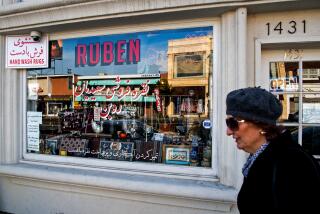It Didn’t Start With the Ayatollah : THE EAGLE AND THE LION The Tragedy of American-Iranian Relations <i> by James A. Bill (Yale University Press: $25; 544 pp.) </i> : ISLAM AND REVOLUTION IN THE MIDDLE EAST <i> by Henry Munson Jr. (Yale University Press: $18.95; 176 pp.) </i>
- Share via
On May 25, 1986, former National Security Council chief Robert McFarlane, Lt. Col. Oliver North and four others, their identities thinly disguised by Irish passports, boarded a black Boeing 707 in Tel Aviv for the last leg of their secret mission to Tehran to swap arms for hostages.
That ill-fated episode, which ended in a stormy stalemate that still haunts the Reagan Administration, marked the latest disaster in a policy poorly conceived--and even more poorly conducted--ever since the U.S. replaced Britain as the main Western influence in Iran, according to James Bill, author of “The Eagle and the Lion: The Tragedy of American-Iranian Relations.”
Iran-Contra was not the first U.S. debacle with the theocrats. In a campaign also pegged to cultivating “moderate” leadership, the U.S. clumsily tried to recruit Abol Hassan Bani Sadr, later the Islamic Republic’s first president, for the CIA in 1979. Documents uncovered by the student captors of the American embassy, revealing the scheme and Bani Sadr’s code name as “SDLure/1,” were the final evidence used in ousting him from power. He ended up fleeing Iran in 1981.
With meticulous yet spellbinding detail, Bill, a noted Iran scholar at the College of William and Mary’s Center for International Studies, traces relations from the first American missionaries in 1830 through the costly aftermath of the Iran-Contra ordeal. The pattern of errors is a genuine tragedy.
Trouble began within five years of the U.S. dispatch of a small military advisory team in 1947. In what became a model for later American misadventures, the CIA masterminded the 1953 overthrow of Prime Minister Muhammad Mossadegh, a true nationalist seen as a threat to the West due to his criticism of foreign involvement in Iran and his nationalization of Iranian oil.
Mossadegh learned of the plot, leading a frightened Muhammad Reza Shah Pahlavi to flee to Rome. The CIA then paid mobs to take to the streets, forcing Mossadegh to flee his office. He was arrested and the shah reinstalled on the Peacock Throne. “The 1953 intervention aborted the birth of revolutionary nationalism in Iran that would burst forth 25 years later in a deeply xenophobic and extremist form,” Bill says. It also left a “running wound that bled for 25 years and contaminated America’s relations with Iran.”
After the shah’s brush with disaster, a strong U.S. presence became an integral part of Iranian politics. Under Eisenhower, the U.S. helped the shah establish the draconian SAVAK secret police and signed a defense pact with Tehran.
During the brief Kennedy years, the shah, also briefly, responded to U.S. pressure to shift from military to economic development. But the White Revolution only superficially addressed reforms. In a fiery 1963 speech marking his political debut, Ayatollah Khomeini condemned the shah’s ongoing tyranny. His arrest two days later established the Imam as a national leader and introduced religion as an idiom of modern opposition.
Under Lyndon Johnson, the U.S. pushed an Iranian law immunizing the U.S. military from prosecution for any offense. Khomeini again led dissent, for which he was deported. Preoccupied by Vietnam, Johnson was so grateful for the shah’s support that he agreed to major arms sales.
Oblivious to the shah’s eroding popularity and his human rights abuses, the Nixon Administration offered Tehran military carte blanche in return for protection of U.S. Persian Gulf interests. The arms deals set historic precedents; Iran’s forces could not absorb the hardware.
More troublesome was the ignorance of political and social shifts in Iran, despite ever-growing intelligence links. This played out in the Carter years in the collapse of the shah and his military and in the birth of a 20th-Century theocracy.
Bill ends by analyzing policy evolution in Washington over four decades. His harsh criticism of certain officials may trigger controversy, but his 12 lessons from the U.S. experience in Iran could well be applied to other foreign policy areas.
“Islam and Revolution in the Middle East” by Henry Munson Jr. tries to explain why Islam has been a revolutionary force only in Iran. The University of Maine anthropologist contrasts Shi’ism, Iran’s dominant sect, with mainstream Sunni tenets to show the unique beliefs that contributed to Iran’s upheaval. He compares Iran’s Islamic movement with others in Saudi Arabia, Egypt and Syria to argue that other Muslim revolutions seem unlikely.
Finally, Munson plugs Islam into Iranian politics. Three factors shaped the revolution: first, the shah’s resented social modernization; second, the rejection of outside domination, symbolized by the charismatic Khomeini; third, President Carter’s human rights policy.
Revolutions occur, he writes, “only when the ancient regime has been crippled by a specific crisis that renders it incapable of suppressing radical opposition. The Carter human rights policy triggered such a crisis in Iran.”
Perceptions that the shah was losing some of the U.S. support needed to prop up the monarchy clearly helped create a window of opportunity. But Munson is on dangerous ground, for the evidence suggests the Pahlavi dynasty was already doomed.
Both books, however, contribute to better understanding of the forces at play in Iran, an understanding that could help prevent repeating the mistakes of the past. And, as Bill predicts, “Although the 1986-87 revelations have set the timetable back, there will be another attempt. . . . The American eagle cannot afford to be out of communication with the Iranian lion, the most powerful force in the Persian Gulf.”
More to Read
Sign up for Essential California
The most important California stories and recommendations in your inbox every morning.
You may occasionally receive promotional content from the Los Angeles Times.













